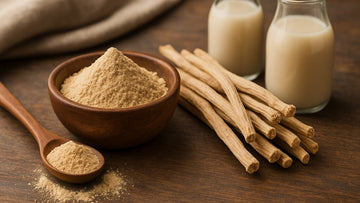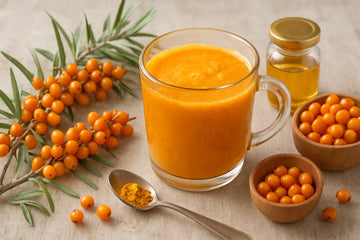Saffron is the world's most expensive spice—and for good reason. Often called "red gold," it’s prized for its rich colour, unique aroma, and impressive health benefits. However, its high value also attracts counterfeiters. If you’re health-conscious and looking to incorporate authentic saffron into your routine, learning how to identify original saffron is important.
Here’s a straightforward, practical guide on spotting real kesar. Ensure you enjoy the best quality saffron without falling for fakes.
Why You Need to Know How to Find Original Saffron
Fake saffron is surprisingly common. It’s made by dyeing safflower, corn silk, coconut fibres or even meat strands to mimic the look of genuine threads. Some sellers also coat inferior saffron with oil, sugar, or salt to increase weight and make it look more appealing. Knowing how to find original saffron protects your health and your investment.
Seven Reliable Methods to Identify Real Kesar
1. Cold Water Test
Drop a few saffron threads into a bowl of cold water and wait 10-15 minutes. Genuine saffron will slowly release a golden-yellow hue without the threads losing their red colour. Fake saffron tends to bleed immediately, colouring the water dark red, and the threads often turn pale or white.
2. Baking Soda Test
Mix a pinch of baking soda in water and add saffron threads. Pure saffron will gradually turn the mixture yellow. If the water turns reddish or orange quickly, it’s a sign that the saffron might be artificial.
3. Taste and Aroma
Pure saffron tastes bitter, not sweet. If your saffron has a sugary taste, it’s likely been tampered with. The authentic aroma of real kesar is compared to a mix of honey and dry hay. Freshly harvested saffron will smell stronger. But as it ages, the scent becomes sharper.
4. Rub Test Between Fingers
Gently rub a few threads between your fingers after soaking them briefly in cold water. Authentic saffron will feel firm and release a yellow or orangish colour when rubbed. Fake threads crumble easily into dust or feel greasy due to additives.
5. Paper Test
Place a few threads between two clean sheets of white paper and press lightly. Genuine saffron will not leave any oily stains. If the paper shows oily or greasy spots, the saffron likely contains additives.
6. Appearance Check
Real saffron threads have a distinctive trumpet shape. They are thicker at one end and taper toward the other. Counterfeit saffron strands, like those made from dyed plants or silk fibres, lack the characteristic shape.
7. Petrol Test (Optional)
Drop saffron into a small amount of petrol. Real saffron will not dissolve or release colour in petrol. If the liquid changes colour, your saffron is likely fake.
Exploring Saffron Varieties
Not all saffron is created equal. Knowing a bit about saffron varieties can help you identify the best quality saffron:
- Kashmiri Saffron: Deep red, thick strands with strong aroma and flavour.
- Iranian Saffron: Bright red threads with a slightly milder aroma but potent colouring power.
- Spanish Saffron: High-quality but often lighter in colour compared to Kashmiri and Iranian.
- Top-grade saffron varieties usually have minimal yellow or white parts, indicating higher potency.
Best Quality Saffron Traits
The best saffron threads are:
- Deep red with minimal yellow.
- Strongly aromatic.
- Trumpet-shaped at one end.
- Dry but not brittle.
- Bitter to taste (never sweet).
Also, buying from trusted brands that provide laboratory certification ensures you’re getting authentic saffron, tested according to ISO 3632 standards for flavour, colour, and aroma strength.
Saffron Testing Methods to Avoid Common Scams
Fake saffron scams typically involve:
- Selling dyed safflower (a plant that looks similar but lacks flavour and aroma).
- Adding weight using oils, sugar, salt, or honey.
- Mixing dyed fibres or threads with genuine saffron.
Simple home tests like the cold water and paper tests help expose these scams easily. When in doubt, always check for original saffron seeds and certified sourcing.
Risks of Using Fake Saffron
Using counterfeit saffron isn’t just a waste of money—it can be risky. Contaminated or adulterated saffron might cause allergic reactions, digestive issues, or introduce harmful chemicals into your diet. Especially if you're using saffron for health purposes, choosing genuine products is crucial.
Kesar Flavour: How Real Saffron Enhances Food and Health
Real kesar adds a deep, earthy aroma and a golden hue to dishes like biryani, kheer, and saffron milk. Beyond flavour, it offers:
- Antioxidant support.
- Improved mood and mental clarity.
- Better digestion.
- Potential heart and skin health benefits.
But fake saffron won’t deliver these perks, making careful selection even more important.
Where to Buy Authentic Saffron
Always choose reputable suppliers who are transparent about sourcing. Look for ISO-certified saffron brands that test their products for quality and purity.
Buying cheap saffron from unverified sources increases the risk of getting a counterfeit product. Genuine saffron is never "cheap," but a little goes a long way—so it’s a worthwhile investment.
Also read: List of Kesar Sweets: Flavorful Tradition with Health Perks
Final Thoughts
Learning how to identify original saffron empowers you to enjoy the true benefits of this precious spice. By mastering simple saffron testing methods and understanding what real kesar looks, tastes, and smells like, you can make confident, informed choices.
Whether you're enhancing your wellness routine or simply adding flavour to your favourite dishes, choosing the best quality saffron ensures you get the full health and culinary value nature intended.
You can Buy saffron online – Lab-Certified Pure Kashmiri Mongra Saffron now available at My Pahadi Dukan.
Suggested - Saffron Benefits for Skin: A Natural Beauty Boost
FAQs
How to know saffron is pure?
Pure saffron has vibrant red threads with a trumpet-shaped tip. It smells sweet, floral and slightly bitter. Genuine saffron threads turn water golden-yellow slowly; fake ones immediately bleed colour or float loosely.
Does saffron expire?
Yes, saffron can expire. Stored properly in a cool, dry, and dark place, saffron maintains its quality for up to 2-4 years. Over time, its aroma, flavour, and potency gradually diminish.
Does real saffron dissolve in water?
Real saffron threads do not fully dissolve in water. Instead, genuine saffron slowly releases colour, turning the water yellow-gold. Threads remain intact, whereas fake saffron quickly dissolves, losing structure completely.
How to identify original saffron at home?
At home, perform a quick water test by soaking saffron threads in warm water. Real saffron gradually colours the water golden-yellow without disintegrating, whereas fake saffron immediately releases dye and quickly dissolves.










